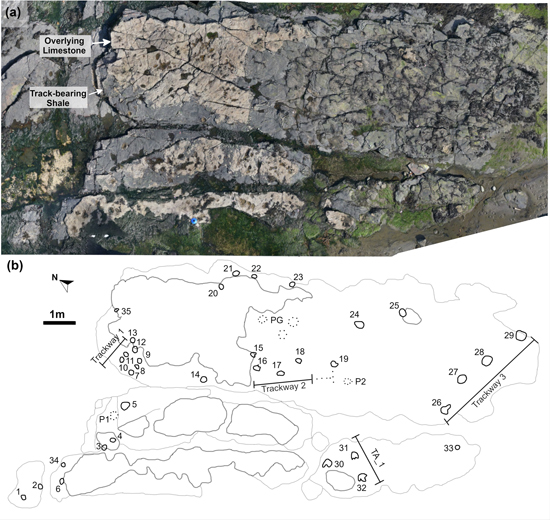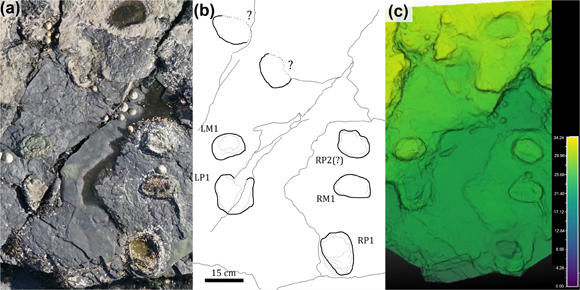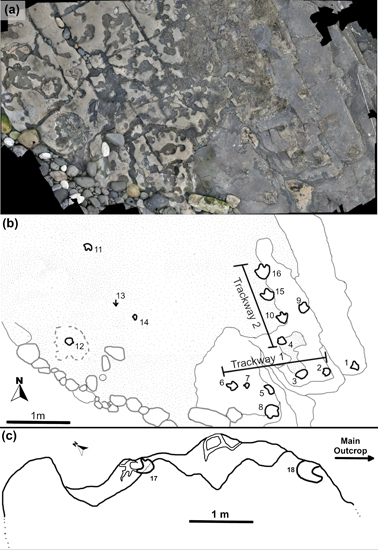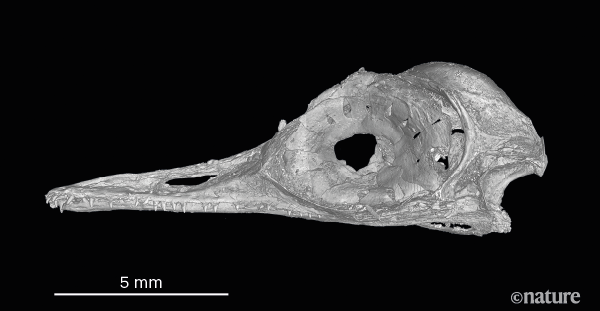Amazing Scottish Stegosaurs
Scottish Island – A Dinosaur Stomping Ground Complete with Stegosaurs
Scientists led by researchers from Edinburgh University have reported the discovery of dozens of dinosaur footprints preserved in exposed mudstones at two locations on the Isle of Skye. The trace fossils preserve evidence of a variety of different types of dinosaurs, which helps palaeontologists to gain a better understanding of dinosaur distribution and diversity during the Middle Jurassic.
The tracks indicate a variety of dinosaur trackmakers, including bipedal theropods of various sizes, possible ornithopods and a quadrupedal ornithischian dinosaur, the tracks of which show a resemblance to the ichnotaxon Deltapodus, which is believed to represent a stegosaur. If these prints do represent a member of the Stegosauria, then this is the first time that evidence for this type of armoured dinosaur has been discovered on the Isle of Skye.
Dinosaurs Congregating Around Mudflats on the Isle of Skye (Middle Jurassic)

Picture credit: Jon Hoad
Globally Important Fossil Discovery
During the Middle Jurassic the Dinosauria rapidly diversified and many new types evolved. Unfortunately, the fossil record for terrestrial vertebrates from the Middle Jurassic is particularly poor. The abundant trace fossils associated with the Isle of Skye are globally important, providing scientists with an opportunity to plot which types of dinosaurs are associated with this location. Since the first dinosaur footprint in Scotland was found in the 1980s numerous tracksites representing several ichnotaxa have been recorded.
Writing in the academic journal PLOS One, the researchers describe two new tracksites from Rubha nam Brathairean (Brothers Point). The sites are referred to as BP1 and BP3, site BP2, which revealed sauropod and theropod prints has already been reported upon: Isle of Skye Steps into the Jurassic Spotlight (2018).
An Aerial View and Line Drawing of BP1 Showing the Distribution of the Dinosaur Tracks

Picture credit: PLOS One
An Insight into the Fauna Around a Subtropical Coastal Area
The trace fossils at both BP1 and BP3 were formed when mudflats were exposed and dinosaurs walked over them. Today, the mudstones comprise part of the Lealt Shale Formation of the Great Estuarine Group. The dinosaurs inhabited a coastal environment in what was a subtropical climate. The fossil bearing rocks might be exposed on the coast today, but the climate on the Isle of Skye today is very different to what it was like around 170 million years ago. The notorious Scottish weather prevented the researchers from using drones on several occasions in their attempts to photograph and map the sites.
An Aerial View of BP3 and Accompanying Line Drawing Showing the Various Dinosaur Tracks
Picture credit: PLOS One
The tracks at both sites are preserved as impressions (concave epirelief) and the signs of mud cracks associated with the trace fossils suggest that the surfaces of both sites were briefly exposed before being quickly reclaimed by the return of brackish water. Whilst the dinosaur tracks at BP3 were being mapped, an articulated pterosaur skeleton was found in the overlying limestone layer. The state of the bones (largely unfractured) and the articulated skeleton suggest that the overlying limestone was deposited in a relatively low energy environment. The pterosaur is currently being studied and will be covered in a future scientific paper.
Evidence of a Scottish Stegosaur
One of the tracks at location BP1 (BP1_Twy-01) shows a series of prints made by a quadrupedal dinosaur. Although the tracks are a little distorted, distinctions between the pes (rear foot) and the manus (front foot) can be made. The researchers conclude that these prints and other, single prints from this site are similar to the ichnotaxon Deltapodus. Evidence of a potential armoured dinosaur from the Isle of Skye adds to the diversity of dinosaur types known from this location.
Mapping the Ornithischian Tracks (Potential Stegosaur – Ichnotaxon Deltapodus)

Picture credit: PLOS One
Together these two new tracksites demonstrate the wide variety of different types of dinosaur present in the area and will help palaeontologists gain more data on the early evolution and radiation of the Dinosauria. As the researchers conclude, essentially BP1 and BP3 provide a snapshot of a “day in the life” of a Middle Jurassic ecosystem.
A Palaeontological Puzzle
No sauropod tracks have been described to date from BP1 or BP3, although they have been found at BP2. The absence of sauropod evidence could be coincidental or perhaps an indication that during the time the mudflats were exposed, these large herbivores were not present in the area. Environmental factors could help to explain the absence of sauropods. Site BP2 represents a shallow lagoon, whilst BP1 and BP3 represent mudflats. The sauropods may have preferred to occupy the lagoons.
The scientific paper: “Novel track morphotypes from new tracksites indicate increased Middle Jurassic dinosaur diversity on the Isle of Skye, Scotland” by Paige E. dePolo, Stephen L. Brusatte, Thomas J. Challands, Davide Foffa, Mark Wilkinson, Neil D. L. Clark, Jon Hoad, Paulo Victor Luiz Gomes da Costa Pereira, Dugald A. Ross and Thomas J. Wade published in the journal PLOS One.
Visit the Everything Dinosaur website: Everything Dinosaur.



